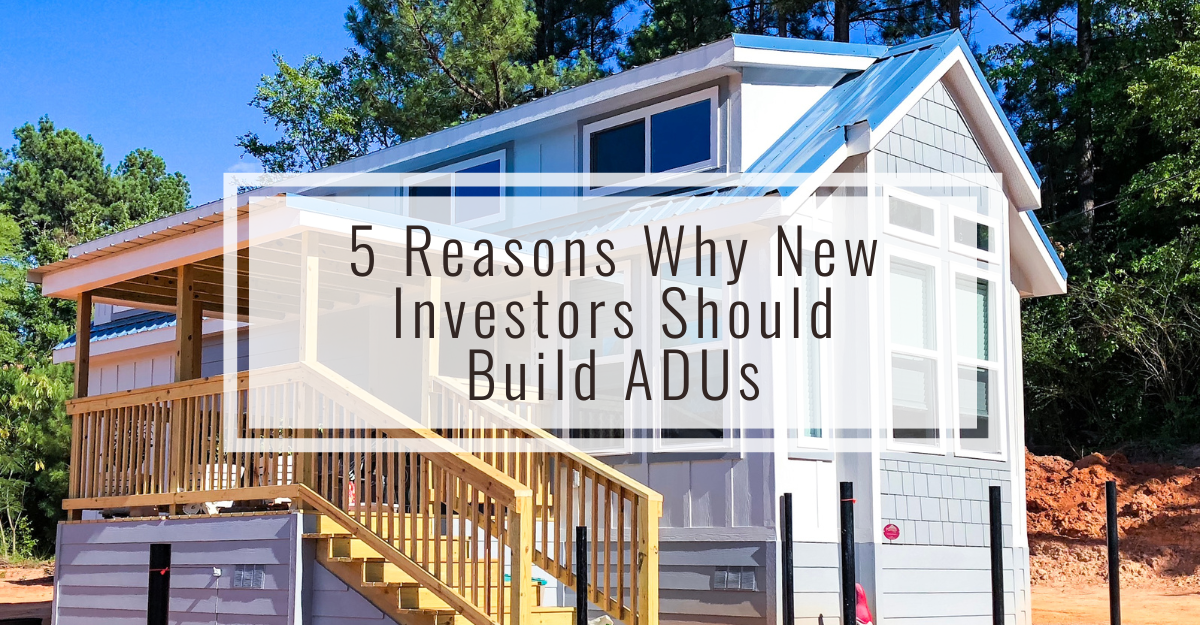
Real estate investors may consider building an ADU to use as a rental property, or income generating property, as part of their portfolio. With ADUs growing in popularity to might be wondering what the benefits are for investors and how to get started. This articles explores cost and affordability, financing, potential rental income and risks associated with ADUs as investment opportunities.
Accessory Dwelling Units (ADUs), sometimes known as granny flats, in-law suites, carriage houses, coach houses, or backyard bungalows are simply a second housing unit added to a single-family residential lot. ADUs are typically tiny homes or garage conversions that act as stand-alone units next to a primary residence.
With much of the country currently dealing with a severe housing affordability crisis, ADUs are experiencing another moment in the sun, and many states have recently passed laws empowering homeowners to add ADUs to their property.
So far, they’ve been successful. For example, in the Los Angeles metro area, permits for ADU construction went from around 2,000 in 2017 to over 13,000 in 2022.
This changing regulatory landscape — combined with a housing market so hot that many young families can’t even afford to get into a starter home — has created a rare opportunity for investors.
Let’s look at five reasons why investors should consider starting with ADUs.
Affordability and Ease of Financing
For a variety of reasons, ADUs are a uniquely affordable way to build new housing. First, you’re likely building your ADU on a lot that you already own, which eliminates the cost of buying new land.
Many ADUs are manufactured housing, which means the structure is fully built off-site, usually at a factory, and transported into place. This is much less expensive than “site-built” construction because it’s more efficient and produces less construction material waste. Freddie Mac estimates that manufactured housing only costs around half as much, per square foot, as conventional site-built construction.
Even if you opt for conventional construction, costs are still very low, relative to building a whole new single-family home. In Los Angeles, where the average home value is just under a million, a study from UC Berkeley estimated the cost of building a new ADU at only $148,000. That’s incredible value for one of the most expensive urban markets in the U.S.
Financing the construction of an ADU can be fairly easy, even if the financing system for ADUs is still pretty rudimentary. Most homeowners who opt to add an ADU to their property use a combination of personal savings and loans from a bank, often through either a home equity loan or a home equity line of credit.
Intriguingly, both Fannie Mae and Freddie Mac offer home renovation loans that can be used to finance the construction of an ADU. In states like California, where policymakers are hoping ADUs can help alleviate high housing costs, substantial government grants are available to homeowners looking to add an ADU.
Increased Property Value
Adding an ADU can be a tremendous boost to your property value. It represents a significant increase in usable living space, boosts the desirability of the property to future buyers, and gives owners a ready-made source of income.
Many lenders will even look at projected rental income from ADUs as part of their loan approval process, and home appraisers are catching up to the tricky science of placing a value on a backyard ADU. As ADUs become more common, and their potential as a source of income becomes clearer, property values should rise even further.
Rental Income Potential
ADUs also offer a rare opportunity for passive rental income, both through long- and short-term rentals. Owners of ADUs routinely rent them out on year-long leases, just like more conventional rentals, while others rent them on platforms like Vrbo or Airbnb.
The cash flow from an ADU rental can offset mortgage payments, and give investors a huge boost in their monthly cash flow; putting them on the short-term rental market also gives owners an opportunity to use them as flexible guest housing for friends and family. And because ADUs tend to be a good distance from the main property, investors can rent them out without any significant disruption to their day-to-day routine.
Favorable Zoning and Regulations
ADUs represent a sort of magic bullet for lawmakers concerned with issues like sustainability, increasing housing density, and housing affordability. They’re a low-impact method of development that benefits property owners and future tenants (or buyers, where ADUs can be sold), and makes much more efficient use of single-family lots. So it’s no surprise that lawmakers around the country have been legalizing ADUs.
On the East Coast, Rhode Island and Massachusetts have legalized ADUs, hoping to alleviate housing pressures that have made cities like Boston and Providence tough for buyers. In Colorado, where Denver has been one of the hottest real estate markets in the U.S. over the past decade, the legislature has passed a law that takes effect in 2025 that effectively erases existing prohibitions on ADUs, as well as making it much easier for urban Colorado residents to build ADUs. And California has passed a series of laws designed to encourage ADU construction in hyper-expensive markets like San Jose.
Lower Risk for New Investors
ADUs are a great option for homeowners with enough space to build an additional unit. ADUs give you a massive equity boost the day they’re complete, and they can be used for both short-term and long-term rentals.
Compared to the high price of admission of buying a traditional property, building an ADU is a great way for novice investors to get into the market. But even for seasoned investors, considering that housing prices are on a steeply upward trajectory, and that the regulatory environment for ADUs has been steadily becoming more favorable, investing in ADUs looks like a no-brainer.